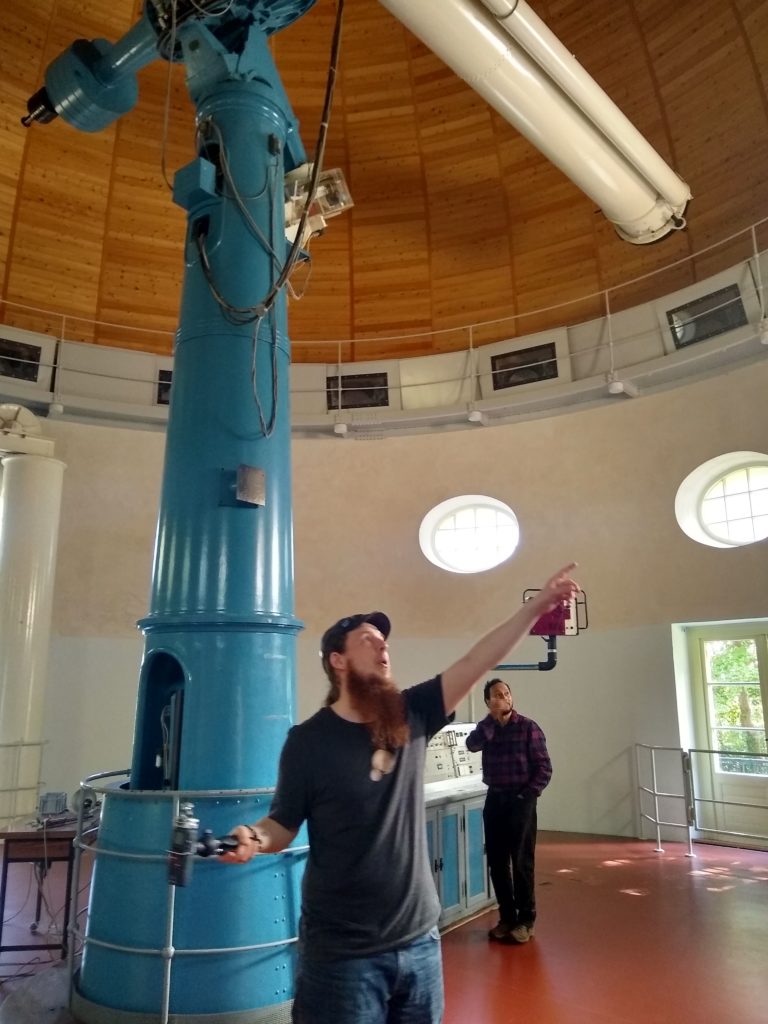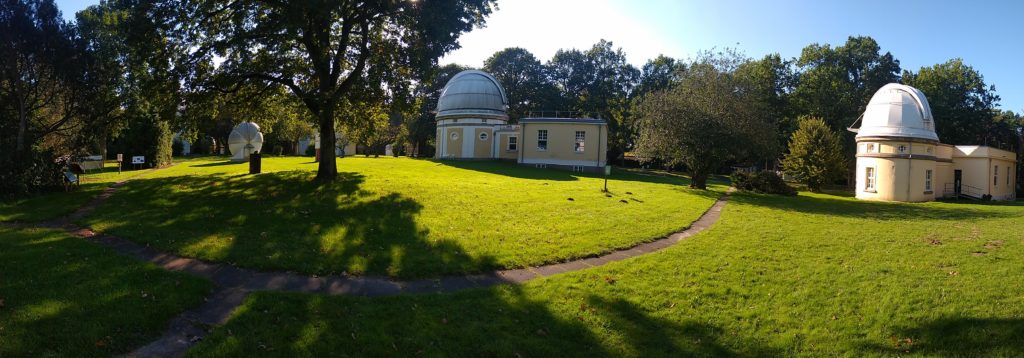Podcast Episode 5: Pranjal Trivedi
In our fifth episode, Pranjal Trivedi, astrophysicist and cosmologist as a postdoctoral researcher at the Hamburg Observatory and the Quantum Universe Cluster of Excellence, talks about dark matter and the ongoing quest of finding it.

“I used to be an observational astronomer before I became a theoretical astrophysicist”, Pranjal tells me and I can see the sparkle in his eyes. He continues to explain how astronomers back in the days peered through a telescope eyepiece for countless hours without moving the tiniest bit, usually while it was freaking cold on long dark winter nights without any heating to avoid blurred images. I am sure I forgot most of the technical details I learned but I certainly did not forget the enthusiasm and excitement about all things astro that Pranjal got me infected with.

Did I already tell you how nice it was at the Observatory?
I already tried to describe the beautiful sunny afternoon on which we recorded episodes 4 and 5 at the Hamburg Observatory in last week’ post about Caroline’s episode. However, if you think I am probably overselling the setting, take Pranjal’s word for it. In the very beginning of this episode you can listen to me talking to him while we are sitting on a bench in the sunny Observatory park.
You will get a rough idea about my social awkwardness when hearing how I blatantly asked Pranjal how old he is after just a few minutes. To my defense: I was so incredibly stunned to learn about all the things he already did and achieved in his life. 🙂
For everyone who wants to jump right into the more scienc-y part in which Michael and Pranjal talk about dark matter, it starts at about 04:15.

Content
In this podcast, Michael and Pranjal dive into the big physics mystery of dark matter. Why do astronomers assume there must be 5 times more matter in the Universe than we know about? This matter is called dark matter because it seems invisible using light, yet it makes a heavy presence felt via gravity. It’s not made up of any atoms or ions like our bodies, the Earth or stars. It also does not match any subatomic particle discovered so far in physics experiments. So, what is it? Take a listen to find out why Hamburg scientists are busy doing theory and experiments hunting for dark matter in the form of the ‘axion’.



















Thank you Michael and Pranjal for the podcast, it was fun and informative.
I however have a question concerning Dark Matter. We have been looking for Dark Matter for more than a couple decades now. What I can’t seem to understand is why such a abundant “particle”, that gravitationally interacts with matter, is also almost impossible to detect, both directly and indirectly. Pranjal mentioned that MOND was discarded in the late 1900s, however it was able to explain what normal Newtonian mechanics lacked and was also consistent when studying other aspects of galaxy rotations. I do understand that MOND is not the only solution, as it cannot be used to explain the rotations of galaxy clusters. But isn’t working on MOND to find a better solution to gravity a more optimal solution that just looking in the dark for a dark particle? Even Einstein was able to expand on the idea of gravity and for more than 100 years now we still don’t have a better theory than what he was able to come up with.
Thanks again for the talk. Looking forward for the next ones.
Thanks for your question! I don’t have a physical argument to offer, as I would rather leave that to Pranjal 🙂
But I would offer a cultural argument: At first glance, it seems easier and more elegant to just modify an existing, well-working theory like the General Theory of Relativity. In contrast, finding a strangely-behaved particle that doesn’t fit anywhere in the Standard Model of Particle Physics might look messy and unattractive. However, I would argue that most physicists actually feel the other way around, and this is for two reasons.
Firstly, finding new and strangely behaved particles has been an amazing success story throughout modern physics. It started in the 1930s with the discoveries of the neutron and muon and the theoretical suggestion of the neutrino. From the 1950s through the 1970s, the whole “particle zoo” of mesons and strange baryons and heavy quarks joined the party, as well as the W and Z bosons and the gluon towards the 1980s. New discoveries have slowed down since then, the heaviest quarks and neutrinos were found in the mid-to-late 1990s, and lately “only” the Higgs boson and some exotic heavy hadrons like tetraquarks and pentaquarks have been added to the collection. So, finding strangely-behaved new particles isn’t really something that most physicists would find unattractive, because it’s been such a success story in building the Standard Model, and so it’s hoped that discovering Beyond-Standard-Model Physics will work the same way. Granted, this hasn’t worked so far: SUSY is practically dead, and no other particle has appeared and broken the Standard Model so far. But I’d suggest that many physicists still feel that’s how it should work. And if it solves long-standing mysteries in cosmology, all the better!
The second reason is that (insert meme picture here): One does not simply modify General Relativity. It’s as close to a perfect physical theory as anything we’ve seen in the last 120 years. It has passed mind-boggling tests for over a century, from the orbit of Mercury and Eddington’s solar eclipse of 1919, through the measurement of gravitational time dilation in quantum measurements, and recently all the way to perfect predictions of Gravitational Waves from Black Hole mergers. It’s certainly the most successful physical theory of the past century, and for many, it’s also the most elegant and beautiful physical theory in existence.
So, if physicists are made to choose between “messing around” with General Relativity or finding “just another weird particle”, I think the particle seems the more natural way to go 🙂
Of course, there are numerous exceptions, and research isn’t usually (and shouldn’t be!) guided by feelings. But I think these cultural aspects do have some importance.